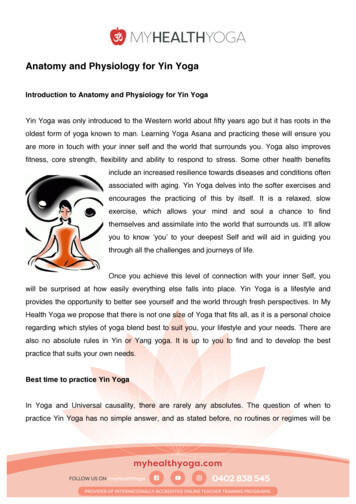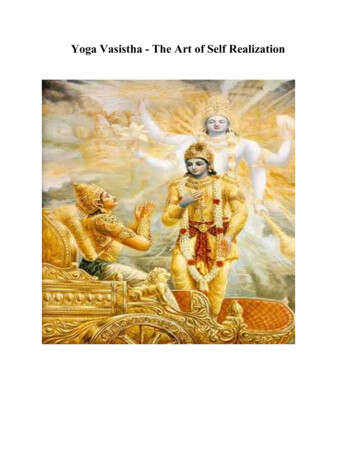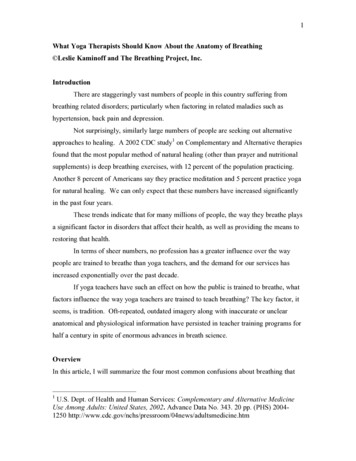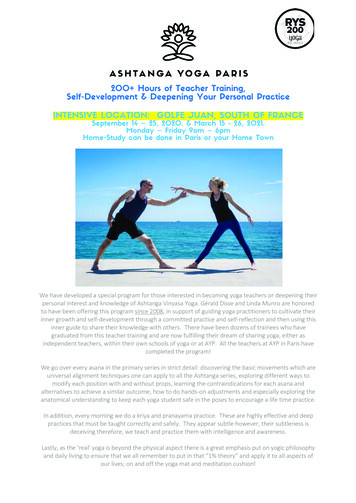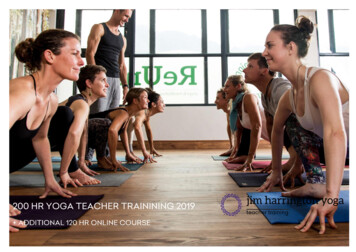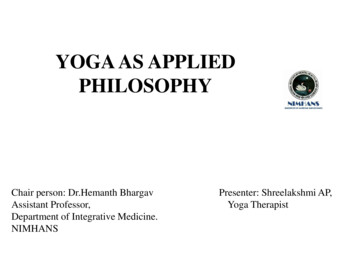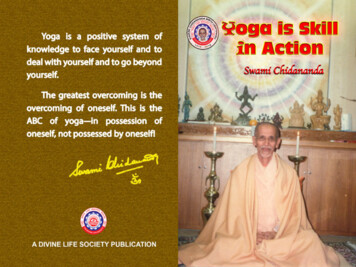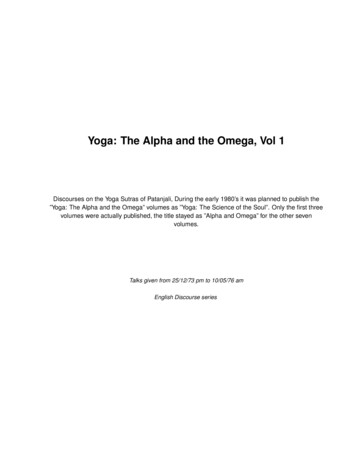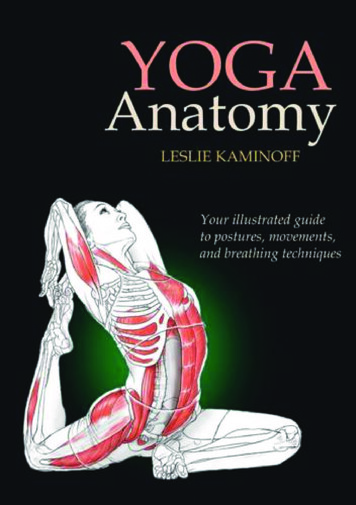
Transcription
YOGAANATOMYLeslie KaminoffAsana Analysis byAmy MatthewsIllustrated bySharon EllisHuman Kinetics
Library of Congress Cataloging-in-Publication DataKaminoff, Leslie.Yoga anatomy / Leslie Kaminoff ; illustrated by Sharon Ellis.p. cm.Includes indexes.ISBN-13: 978-0-7360-6278-7 (soft cover)ISBN-10: 0-7360-6278-5 (soft cover)1. Hatha yoga. 2. Human anatomy. I. Title.RA781.7.K356 2007613.7’046--dc222007010050ISBN-10: 0-7360-6278-5 (print)ISBN-13: 978-0-7360-6278-7 (print)ISBN-10: 0-7360-8218-2 (Adobe PDF)ISBN-13: 978-0-7360-8218-1 (Adobe PDF)Copyright 2007 by The Breathe TrustAll rights reserved. Except for use in a review, the reproduction or utilization of this work in any form orby any electronic, mechanical, or other means, now known or hereafter invented, including xerography,photocopying, and recording, and in any information storage and retrieval system, is forbidden without thewritten permission of the publisher.Acquisitions Editor: Martin BarnardDevelopmental Editor: Leigh KeylockAssistant Editor: Christine HorgerCopyeditor: Patsy FortneyProofreader: Kathy BennettGraphic Designer: Fred StarbirdGraphic Artist: Tara WelschOriginal Cover Designer: Lydia MannCover Revisions: Keith BlombergArt Manager: Kelly HendrenProject Photographer: Lydia MannIllustrator (cover and interior): Sharon EllisPrinter: United GraphicsHuman Kinetics books are available at special discounts for bulk purchase. Special editions or book excerptscan also be created to specification. For details, contact the Special Sales Manager at Human Kinetics.Printed in the United States of America10 9 8 7 6 5 4 3 2 1Human KineticsWeb site: www.HumanKinetics.comUnited States: Human KineticsP.O. Box 5076Champaign, IL 61825-5076800-747-4457e-mail: humank@hkusa.comAustralia: Human Kinetics57A Price AvenueLower Mitcham, South Australia 506208 8372 0999e-mail: info@hkaustralia.comCanada: Human Kinetics475 Devonshire Road Unit 100Windsor, ON N8Y 2L5800-465-7301 (in Canada only)e-mail: info@hkcanada.comNew Zealand: Human KineticsDivision of Sports Distributors NZ Ltd.P.O. Box 300 226 AlbanyNorth Shore CityAuckland0064 9 448 1207e-mail: info@humankinetics.co.nzEurope: Human Kinetics107 Bradford RoadStanningleyLeeds LS28 6AT, United Kingdom 44 (0) 113 255 5665e-mail: hk@hkeurope.com
To my teacher, T.K.V. Desikachar, I offer this book in gratitude for his unwavering insistencethat I find my own truth. My greatest hope is that this work can justify his confidence inme.And, to my philosophy teacher, Ron Pisaturo—the lessons will never end.—Leslie KaminoffIn gratitude to all the students and teachers who have gone before . . . especially Philip,my student, teacher, and friend.—Amy Matthews
ContentsAcknowledgmentsviiIntroductionixC ha p t e r1 Dynamics ofC ha p t e r2 Yoga and the Spine . . 17C ha p t e r3 UnderstandingC ha p t e r4 Standing Poses . . . . . . 33C ha p t e r5 Sitting Poses . . . . . . . 79C ha p t e r6 Kneeling Poses . . . . . 119C ha p t e r7 Supine Poses . . . . . . . 135C ha p t e r8 Prone Poses . . . . . . . 163C ha p t e r9 Arm SupportBreathing . . . . . . . . . . . 1the Asanas . . . . . . . . . 29Poses . . . . . . . . . . . . . 175References and Resources211Asana Indexes in Sanskrit and EnglishAbout the Author213219About the CollaboratorAbout the Illustrator220221
acknowledgmentsFirst and foremost, I wish to express my gratitude to my family—my wife Uma, and mysons Sasha, Jai, and Shaun. Their patience, understanding, and love have carried methrough the three-year process of conceiving, writing, and editing this book. They havesacrificed many hours that they would otherwise have spent with me, and that’s what madethis work possible. I am thankful beyond measure for their support. I wish also to thank myfather and mother for supporting their son’s unconventional interests and career for thepast four decades. Allowing a child to find his own path in life is perhaps the greatest giftthat a parent can give.This has been a truly collaborative project which would never have happened withoutthe invaluable, ongoing support of an incredibly talented and dedicated team. Lydia Mann,whose most accurate title would be “Project and Author Wrangler” is a gifted designer, artist,and friend who guided me through every phase of this project: organizing, clarifying, andediting the structure of the book; shooting the majority of the photographs (including theauthor photos); designing the cover; introducing me to BackPack, a collaborative Web-basedservice from 37 Signals, which served as the repository of the images, text, and informationthat were assembled into the finished book. Without Lydia’s help and skill, this book wouldstill be lingering somewhere in the space between my head and my hard drive.My colleague and collaborator Amy Matthews was responsible for the detailed and innovative asana analysis that forms the backbone of the book. Working with Amy continues tobe one of the richest and most rewarding professional relationships I’ve ever had.Sharon Ellis has proven to be a skilled, perceptive, and flexible medical illustrator. WhenI first recruited her into this project after admiring her work online, she had no familiaritywith yoga, but before long, she was slinging the Sanskrit terms and feeling her way throughthe postures like a seasoned yoga adept.This project would never have existed had it not been originally conceived by the teamat Human Kinetics. Martin Barnard’s research led to me being offered the project in thefirst place. Leigh Keylock and Jason Muzinic’s editorial guidance and encouragement keptthe project on track. I can’t thank them enough for their support and patience, but mostlyfor their patience.A very special thank you goes to my literary agent and good friend, Bob Tabian, whohas been a steady, reliable voice of reason and experience. He’s the first person who sawme as an author, and never lost his faith that I could actually be one.For education, inspiration, and coaching along the way, I thank Swami Vishnu Devananda, Lynda Huey, Leroy Perry Jr., Jack Scott, Larry Payne, Craig Nelson, Gary Kraftsow, YanDhyansky, Steve Schram, William LeSassier, David Gorman, Bonnie Bainbridge Cohen, LenEaster, Gil Hedley, and Tom Myers. I also thank all my students and clients past and presentfor being my most consistent and challenging teachers.A big thank you goes out to all the models who posed for our images: Amy Matthews,Alana Kornfeld, Janet Aschkenasy, Mariko Hirakawa (our cover model), Steve Rooney (whoalso donated the studio at International Center of Photography for a major shoot), EdenKellner, Elizabeth Luckett, Derek Newman, Carl Horowitz, J. Brown, Jyothi Larson, NadiyaNottingham, Richard Freeman, Arjuna, Eddie Stern, Shaun Kaminoff, and Uma McNeill.Thanks also go to the Krishnamacharya Yoga Mandiram for permission to use the iconicphotographs of Sri T. Krishnamacharya as reference for the Mahamudra and Mulabandhasana drawings.vii
viiiAcknowledgmentsInvaluable support for this project was also provided by Jen Harris, Edya Kalev, LeandroVillaro, Rudi Bach, Jenna O’Brien, and all the teachers, staff, students, and supporters ofThe Breathing Project.—Leslie KaminoffThanks to Leslie for inviting me to be a part of it all . . . little did I know what that “coolidea” would become! Many thanks to all of the teachers who encouraged my curiosity andpassion for understanding things: especially Alison West, for cultivating a spirit of exploration and inquiry in her yoga classes; Mark Whitwell, for constantly reminding me of whatI already know about why I am a teacher; Irene Dowd, for her enthusiasm and precision;and Bonnie Bainbridge Cohen, who models the passion and compassion for herself and herstudents that lets her be such a gift as a teacher.And I am hugely grateful to all the people and circles that have sustained me in the process of working on this book: my dearest friends Michelle and Aynsley; the summer BMCcircle, especially our kitchen table circle, Wendy, Elizabeth, and Tarina; Kidney, and all thepeople I told to “stop asking!”; my family; and my beloved Karen, without whose love andsupport I would have been much more cranky.—Amy Matthews
IntroductionThis book is by no means an exhaustive, complete study of human anatomy or the vastscience of yoga. No single book possibly could be. Both fields contain a potentially infinite number of details, both macro- and microscopic—all of which are endlessly fascinatingand potentially useful in certain contexts. My intention is to present what I consider to bethe key details of anatomy that are of the most value and use to people who are involvedin yoga, whether as students or teachers.To accomplish this, a particular context, or view, is necessary. This view will help sort outthe important details from the vast sea of information available. Furthermore, such a viewwill help to assemble these details into an integrated view of our existence as “indivisibleentities of matter and consciousness.”1The view of yoga used in this book is based on the structure and function of the humanbody. Because yoga practice emphasizes the relationship of the breath and the spine, I willpay particular attention to those systems. By viewing all the other body structures in lightof their relationship to the breath and spine, yoga becomes the integrating principle for thestudy of anatomy. Additionally, for yoga practitioners, anatomical awareness is a powerfultool for keeping our bodies safe and our minds grounded in reality.The reason for this mutually illuminating relationship between yoga and anatomy issimple: The deepest principles of yoga are based on a subtle and profound appreciation ofhow the human system is constructed. The subject of the study of yoga is the Self, and theSelf is dwelling in a physical body.The ancient yogis held the view that we actually possess three bodies: physical, astral,and causal. From this perspective, yoga anatomy is the study of the subtle currents of energythat move through the layers, or “sheaths,” of those three bodies. The purpose of this workis to neither support nor refute this view. I wish only to offer the perspective that if you arereading this book, you possess a mind and a body that is currently inhaling and exhaling ina gravitational field. Therefore, you can benefit immensely from a process that enables youto think more clearly, breathe more effortlessly, and move more efficiently. This, in fact, willbe our basic definition of yoga practice: the integration of mind, breath, and body.This definition is the starting point of this book, just as our first experience of breath andgravity was the starting point of our lives on this planet.The context that yoga provides for the study of anatomy is rooted in the exploration ofhow the life force expresses itself through the movements of the body, breath, and mind.The ancient and exquisite metaphorical language of yoga has arisen from the very real anatomical experimentations of millions of seekers over thousands of years. All these seekersshared a common laboratory—the human body. It is the intention of this book to providea guided tour of this “lab” with some clear instructions for how the equipment works andwhich basic procedures can yield useful insights. Rather than being a how-to manual forthe practice of a particular system of yoga, I hope to offer a solid grounding in the principlesthat underlie the physical practice of all systems of yoga.I’m inspired here by a famous quote from philosopher and novelist Ayn Rand: “You are an indivisible entity of matter andconsciousness. Renounce your consciousness and you become a brute. Renounce your body and you become a fake. Renouncethe material world and you surrender it to evil.”1ix
introductionA key element that distinguishes yoga practice from gymnastics or calisthenics is theintentional integration of breath, posture, and movement. The essential yogic concepts thatrefer to these elements are beautifully expressed by a handful of coupled Sanskrit a/dukhaTo understand these terms, we must understand how they were derived in the first place:by looking at the most fundamental functional units of life. We will define them as we goalong.To grasp the core principles of both yoga and anatomy, we will need to reach back tothe evolutionary and intrauterine origins of our lives. Whether we look at the simplestsingle-celled organisms or our own beginnings as newly conceived beings, we will find thebasis for the key yogic metaphors that relate to all life and that illuminate the structure andfunction of our thinking, breathing, moving human bodies.
Cpte1The most basic unit of life, the cell, can teach you an enormous amount about yoga. Infact, the most essential yogic concepts can be derived from observing the cell’s formand function. This chapter explores breath anatomy from a yogic perspective, using thecell as a starting point.Yoga Lessons From a CellCells are the smallest building blocks of life, from single-celled plants to multitrillion-celledanimals. The human body, which is made up of roughly 100 trillion cells, begins as a single,newly fertilized cell.A cell consists of three parts: the cell membrane, the nucleus, and the cytoplasm. Themembrane separates the cell’s external environment, which contains nutrients that the cellrequires, from its internal environment, which consists of the cytoplasm and the nucleus.Nutrients have to get through the membrane, and once inside, the cell metabolizes thesenutrients and turns them into the energy that fuels its life functions. As a result of thismetabolic activity, waste gets generated that must somehow get back out through themembrane. Any impairment in the membrane’s ability to let nutrients in or waste out willresult in the death of the cell via starvation or toxicity. This observation that living thingstake in nutrients provides a good basis for understanding the term prana, which refers towhat nourishes a living thing. Prana refers not only to what is brought in as nourishmentbut also to the action that brings it in.1Of course, there has to be a complementary force. The yogic concept that complementsprana is apana, which refers to what is eliminated by a living thing as well as the action ofelimination.2 These two fundamental yogic terms—prana and apana—describe the essentialactivities of life.Successful function, of course,expresses itself in a particular form.Certain conditions have to existin a cell for nutrition (prana) toenter and waste (apana) to exit.The membrane’s structure has toallow things to pass in and out ofit—it has to be permeable (seefigure 1.1). It can’t be so permeable, however, that the cell wallloses its integrity; otherwise, thecell will either explode from thepressures within or implode fromFigure 1.1 The cell’s membrane must balance containthe pressures outside.ment (stability) with permeability.The Sanskrit word prana is derived from pra, a prepositional prefix meaning “before,” and an, a verb meaning “to breathe,”“to blow,” and “to live.” Here, prana is not being capitalized, because it refers to the functional life processes of a single entity.The capitalized Prana is a more universal term that is used to designate the manifestation of all creative life force.1The Sanskrit word apana is derived from apa, which means “away,” “off,” and “down,” and an, which means “to blow,” “tobreathe,” and “to live.”2 rDynamics of breathingha
Yoga AnatomyIn the cell (and all living things, for that matter), the principle that balances permeabilityis stability. The yogic terms that reflect these polarities are sthira3 and sukha.4 All successfulliving things must balance containment and permeability, rigidity and plasticity, persistenceand adaptability, space and boundaries.5You have seen that observing the cell, the most basic unit of life, illuminates the most basicconcepts in yoga: prana/apana and sthira/sukha. Next is an examination of the structureand function of the breath using these concepts as a guide.Prana and ApanaThe body’s pathways for nutrients and waste are not as simple as those of a cell, but theyare not so complex that you can’t grasp the concepts as easily.Figure 1.2 shows a simplified version of the nutritional and waste pathways. It shows howthe human system is open at the top and at the bottom. You take in prana, nourishment, insolid and liquid form at the top of the system: It enters the alimentary canal, goes throughthe digestive process, and after a lot of twists and turns, the resulting waste moves downand out. It has to go down to get out because the exit is at the bottom. So, the force ofapana, when it’s acting on solid and liquid waste, has to move down to get out.You also take in prana in gaseous form: The breath, like solidand liquid nutrition, enters at the top. But the inhaled air remainsabove the diaphragm in the lungs (see figure 1.3), where itexchanges gases with the capillaries at the alveoli. The wastegases in the lungs need to get out—but they need to get backout the same way they came in. This is why it is said that apanamust be able to operate freely both upward and downward,depending on what type of waste it’s acting on. That is alsowhy any inability to reverse apana’s downward push will resultin an incomplete exhalation.The ability to reverse apana’s downward action is a verybasic and useful skill that can be acquired through yoga training, but it is not something that most people are able to doright away. Pushing downward is the way that most peopleare accustomed to operating their apana because wheneverthere’s anything within the body that needs to be disposed,humans tend to squeeze in and push down. That is why mostbeginning yoga students, when asked to exhale completely, willsqueeze in and push down their breathing muscles as if they’reurinating or defecating.Figure 1.2 Solid and liquid nutrition (blue) enter at the top of thesystem and exit as waste at the bottom. Gaseous nutrition andwaste (red) enter and exit at the top.The Sanskrit word sthira means “firm,” “hard,” “solid,” “compact,” “strong,” “unfluctuating,” “durable,” “lasting,” and“permanent.” English words such as stay, stand, stable, and steady are likely derived from the Indo-European root that gaverise to the Sanskrit term.3The Sanskrit word sukha originally meant “having a good axle hole,” implying a space at the center that allows function; italso means “easy,” “pleasant,” “agreeable,” “gentle,” and “mild.”4Successful man-made structures also exhibit a balance of sthira and sukha; for example, a colander’s holes that are largeenough to let out liquid, but small enough to prevent pasta from falling through, or a suspension bridge that’s flexible enoughto survive wind and earthquake, but stable enough to support its load-bearing surfaces.5
dynamics of breathing Sukha and DukhaThe pathways must be clear of obstructing forcesin order for prana and apana to have a healthyrelationship. In yogic language, this region mustbe in a state of sukha, which literally translatesas “good space.” “Bad space” is referred to asdukha, which is commonly translated as “suffering.”6This model points to the fundamental methodology of all classical yoga practice, which attendsto the blockages, or obstructions, in the systemto improve function. The basic idea is that whenyou make more “good space,” your pranic forceswill flow freely and restore normal function. Thisis in contrast to any model that views the bodyas missing something essential, which has to beadded from the outside. This is why it has beenFigure 1.3 The pathway that air takessaid that yoga therapy is 90 percent about wasteinto and out of the body.removal.Another practical way of applying this insightto the field of breath training is the observation: If you take care of the exhalation, theinhalation takes care of itself.Breathing, Gravity, and YogaKeeping in the spirit of starting from the beginning, let’s look at some of the things thathappen at the very start of life.In utero, oxygen is delivered through the umbilical cord. The mother does the breathing.There is no air and very little blood in the lungs when in utero because the lungs are nonfunctional and mostly collapsed. The circulatory system is largely reversed, with oxygen-richblood flowing through the veins and oxygen-depleted blood flowing through the arteries.Humans even have blood flowing through vessels that won’t exist after birth, because theywill seal off and become ligaments.Being born means being severed from the umbilical cord—the lifeline that sustainedyou for nine months. Suddenly, and for the first time, you need to engage in actions thatwill ensure continued survival. The very first of these actions declares your physical andphysiological independence. It is the first breath, and it is the most important and forcefulinhalation you will ever take in your life.That first inhalation was the most important one because the initial inflation of the lungscauses essential changes to the entire circulatory system, which had previously been gearedtoward receiving oxygenated blood from the mother. The first breath causes blood to surgeinto the lungs, the right and left sides of the heart to separate into two pumps, and thespecialized vessels of fetal circulation to shut down and seal off.That first inhalation is the most forceful one you will ever take because it needs to overcome the initial surface tension of your previously collapsed and amniotic-fluid-filled lungThe Sanskrit word sukha is derived from su (meaning “good”) and kha (meaning “space”). In this context (paired withdukha), it refers to a state of well-being, free of obstacles. Like the “good axle hole,” a person needs to have “good space”at his or her center. The Sanskrit word dukha is derived from dus (meaning “bad”) and kha (meaning “space”). It is generallytranslated as “suffering”; also, “uneasy,” “uncomfortable,” “unpleasant,” and “difficult.”6
Yoga Anatomytissue. The force required (called negative inspiratory force) is three to four times greaterthan that of a normal inhalation.Another first-time experience that occurs at the moment of birth is the weight of the bodyin space. Inside the womb, you’re in a weightless, fluid-filled environment. Then, suddenly,your entire universe expands because you’re out—you’re free. Now, your body can movefreely in space, your limbs and head can move freely in relation to your body, and you mustbe supported in gravity. Because adults are perfectly willing to swaddle babies and movethem from place to place, stability and mobility may not seem to be much of an issue soearly in life, but they are. The fact is, right away you have to start doing something—youhave to find nourishment, which involves the complex action of simultaneously breathing,sucking, and swallowing. All of the muscles involved in this intricate act of survival alsocreate your first postural skill—supporting the weight of the head. This necessarily involvesthe coordinated action of many muscles, and—as with all postural skills—a balancing actbetween mobilization and stabilization. Postural development continues from the headdownward, until you begin walking (after about a year), culminating with the completionof your lumbar curve (at about 10 years of age).To summarize, the moment you’re born, you’re confronted by two forces that were notpresent in utero: breath and gravity. To thrive, you need to reconcile those forces for as longas you draw breath on this planet. The practice of yoga can be seen as a way of consciouslyexploring the relationship between breath and posture, so it’s clear that yoga can help youto deal with this fundamental challenge.To use the language of yoga, life on this planet requires an integrated relationshipbetween breath (prana/apana) and posture (sthira/sukha). When things go wrong withone, by definition they go wrong with the other.The prana/apana concept is explored with a focus on the breathing mechanism. Chapter2 covers the sthira/sukha concept by focusing on the spine. The rest of the book examineshow the breath and spine come together in the practice of yoga postures.Breathing DefinedBreathing is the process of taking air into and expelling it from the lungs. This is a goodplace to start, but let’s define the “process” being referred to. Breathing—the passage of airinto and out of the lungs—is movement, one of the fundamental activities of living things.Specifically, breathing involves movement in two cavities.Movement in Two CavitiesThe simplified illustration of the human body in figure 1.4 shows that the torso consistsof two cavities, the thoracic and the abdominal. These cavities share some properties, andthey have important distinctions as well. Both contain vital organs: The thoracic containsthe heart and lungs, and the abdominal contains the stomach, liver, gall bladder, spleen,pancreas, small and large intestines, kidneys, and bladder, among others. Both cavities arebounded posteriorly by the spine. Both open at one end to the external environment—thethoracic at the top, and the abdominal at the bottom. Both share an important structure, thediaphragm (it forms the roof of the abdominal cavity and the floor of the thoracic cavity).Another important shared property of the two cavities is that they are mobile—theychange shape. It is this shape-changing ability that is most relevant to breathing, becausewithout this movement, the body cannot breathe at all. Although both the abdominal andthoracic cavities change shape, there is an important structural difference in how they doso.The abdominal cavity changes shape like a flexible, fluid-filled structure such as a waterballoon. When you squeeze one end of a water balloon, the other end bulges. That is
dynamics of breathing because water is noncompressible. Yourhand’s action only moves the fixed volumeof water from one end of the flexiblecontainer to the other. The same principleapplies when the abdominal cavity is compressed by the movements of breathing; asqueeze in one region produces a bulge inanother. That is because in the context ofbreathing, the abdominal cavity changesshape, but not volume.In the context of life processes otherthan breathing, the abdominal cavity doeschange volume. If you drink a gallon ofliquid or eat a big meal, the overall volumeof the abdominal cavity will increase asa result of expanded abdominal organs(stomach, intestines, bladder). Anyincrease of volume in the abdominal cavitywill produce a corresponding decrease inthe volume of the thoracic cavity. ThatFigure 1.4 Breathing is thoracoabdominal shapeis why it’s harder to breathe after a bigchange. Inhalation on left, exhalation on right.meal, before a big bowel movement, orwhen pregnant.In contrast to the abdominal cavity, the thoracic cavity changes both shape and volume; itbehaves as a flexible gas-filled container, similar to an accordion bellows. When you squeezean accordion, you create a reduction in the volume of the bellows and air is forced out. Whenyou pull the bellows open, its volume increases and the air is pulled in. This is because theaccordion is compressible and expandable. The same is true of the thoracic cavity, which,unlike the abdominal cavity and its contents, can change its shape and volume.Volume and PressureVolume and pressure are inversely related: When volume increases, pressure decreases,and when volume decreases, pressure increases. Because air always flows toward areas oflower pressure, increasing the volume inside the thoracic cavity (think of an accordion) willdecrease pressure and cause air to flow into it. This is an inhalation.It is interesting to note that in spite of how it feels when you inhale, you are not pullingair into the body. On the contrary, air is pushed into the body by atmospheric pressure thatalways surrounds you. The actual force that gets air into the lungs is outside of the body.The energy you expend in breathing produces a shape change that lowers the pressurein your chest cavity and permits the air to be pushed into the body by the weight of theplanet’s atmosphere.Let’s now imagine the thoracic and abdominal cavities as an accordion stacked on top of awater balloon. This illustration gives a sense of the relationship of the two cavities in breathing; movement in one will necessarily result in movement in the other. Recall that duringan inhalation (the shape change permitting air to be pushed into the lungs by the planet’satmospheric pressure), the thoracic cavity expands its volume. This pushes downward onthe abdominal cavity, which changes shape as a result of the pressure from above.During relaxed, quiet breathing (such as while sleeping), an exhalation is a passive reversalof this process. The thoracic cavity and lung tissue—which have been stretched open duringthe inhalation—spring back to their initial volume, pushing the air out and returning thethoracic cavity to its previous shape. This is referred to as a passive recoil. Any reduction
Yoga Anatomyin the elasticity of these tissues will result in a reduction of the body’s ability to exhale passively—leading to a host of respiratory problems.In breathing patterns that involve active exhaling (such as blowing out candles, speaking, and singing, as well as various yoga exercises), the musculature surrounding the twocavities contracts in such a way that the abdominal cavity is pushed upward into the thoracic cavity, or the thoracic cavity is pushed downward into the abdominal cavity, or anycombination of the two.Three-Dimensional Shape Changes of BreathingBecause the lungs occupy a three-dimensional space in the thoracic cavity, when this spacechanges shape to cause air movement, it changes shape three-dimensionally. Specifically,an inhalation involves the chest cavity increasing i
The reason for this mutually illuminating relationship between yoga and anatomy is simple: The deepest principles of yoga are based on a subtle and profound appreciation of how the human system is constructed. The subject of the study of yoga is the Self, and the Self is
